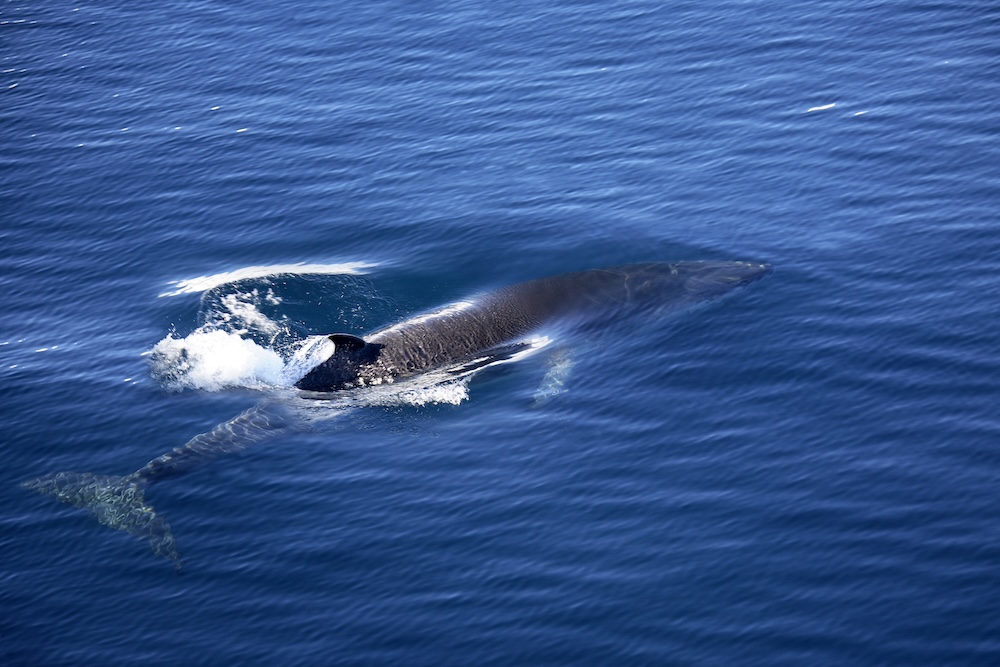The Mediterranean Sea is a jewel of biodiversity — but for the fin whale, the second-largest animal on Earth, it has become one of the most dangerous places to live. Heavy ferry, cruise, and cargo traffic crisscrosses its waters year-round, and those routes often overlap directly with the whales’ feeding and migratory paths between France, Italy, and Spain.
With little in the way of enforceable protections, the Mediterranean’s fin whales face a constant, invisible threat from vessel strikes — a threat that could be dramatically reduced if the region prioritized marine life over maritime convenience.
A Whale Built for the Open Sea, Trapped in a Busy Basin
Fin whales are built for speed and distance. Reaching lengths of up to 80 feet, they can travel thousands of miles in open ocean, cruising at speeds up to 25 miles per hour. But in the semi-enclosed Mediterranean, they navigate a gauntlet of some of the busiest shipping lanes on Earth.
Unlike the wide expanse of the Pacific or Atlantic, the Mediterranean is a relatively small, crowded sea, with its central basin acting as both a highway for ships and a critical habitat for these massive animals.
Why the Mediterranean Is a Deadly Hot Zone
Unregulated Vessel Speeds
In U.S. waters, even voluntary vessel speed reduction zones exist in whale migration areas. In the Mediterranean, there are few — if any — binding regulations requiring ships to slow down. Ferries and cruise ships often operate at high speeds, drastically increasing the likelihood that a collision will be fatal.
Heavy Maritime Traffic Year-Round
The Mediterranean supports an enormous volume of maritime commerce and tourism. High-speed ferries shuttle between port cities, massive container ships connect Europe to Asia and Africa, and cruise liners operate almost continuously during peak season. Fin whales are in harm’s way no matter the time of year.
Overlap of Shipping Lanes and Feeding Grounds
Fin whales feed in plankton-rich waters that often coincide with major shipping corridors. This overlap creates a constant risk — every trip through these zones is a gamble for the whales.
Limited Awareness and Data Sharing
Unlike some other regions, there is no comprehensive, real-time whale detection system integrated with vessel navigation in the Mediterranean. Even if a captain spots a whale, there is no standardized way to alert other vessels.
Why It Matters Beyond the Species
Fin whales play a critical role in the health of the Mediterranean marine ecosystem. Their feeding helps circulate nutrients, stimulating plankton growth — which in turn supports fish populations and captures carbon from the atmosphere.
When a fin whale is killed, it’s not just the loss of an individual. It’s a reduction in the ocean’s ability to store carbon, produce oxygen, and sustain life.
What’s Standing in the Way of Change
The lack of binding maritime regulations in the Mediterranean is partly due to the complexity of governance. Multiple nations share the sea, each with their own laws, economic priorities, and enforcement capabilities. Shipping companies, ferry operators, and cruise lines have resisted measures they see as costly or inconvenient, despite evidence that slowing down could save whales, reduce fuel use, and cut emissions.
What Needs to Happen Now
- Mandatory 10-knot speed limits in known whale habitats, especially in the Ligurian Sea and other high-risk areas.
- Rerouting of shipping lanes away from key feeding grounds when possible.
- Deployment of whale detection and alert systems linked directly to vessel navigation tools.
- International coordination through the International Maritime Organization (IMO) to ensure consistent rules across national waters.
- Public accountability measures requiring cruise and ferry operators to publish whale strike prevention and compliance reports.
The Cost of Doing Nothing
Every high-speed crossing without protection measures is a roll of the dice for Mediterranean fin whales. Because these whales reproduce slowly — a single calf every two to three years — each death takes years to replace, if it’s replaced at all.
If the region continues to delay action, the Mediterranean could follow the path of the Atlantic gray whale — losing an entire population forever.
Final Thoughts
The Mediterranean is not just a human playground or shipping superhighway — it is a living sea that supports some of the largest creatures ever to exist. Protecting fin whales in these waters isn’t just about saving a species. It’s about defending the health, stability, and resilience of the entire marine ecosystem.
The solutions are straightforward. The question is whether we have the will to implement them before more of these giants disappear beneath the waves.









Reader Interactions